










Each town or city in Baja California Sur is different and unique. Road trips in Baja are part of the culture and are very easy to do for someone that is just visiting. Below is a brief description of some of the main areas and destinations to visit, but there is much more to see!
This tourist friendly town, also just known as “Cabo,” is located on the tip of the Baja California peninsula and is full of entertainment for every age and liking. The Sea of Cortez and the Pacific Ocean meet at Land’s End, where you can observe the beautiful rock formations and the famous Cabo Arch. In Cabo San Lucas you can find Medano Beach (the liveliest beach in the Los Cabos area), an impressive marina and countless restaurants and bars that keep the town alive day and night.

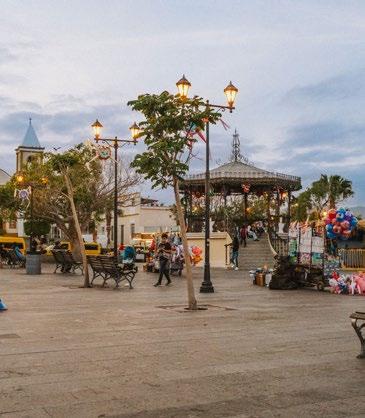

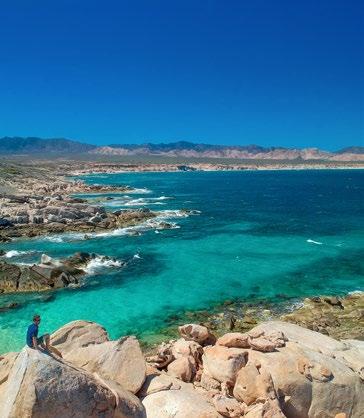

Walking around downtown San José will allow you to experience a traditional Mexican town. You will find yourself surrounded by colorful buildings and quaint cobblestone streets that lead to the town’s picturesque zócalo (main plaza). Over the years, San José has become an artistic and cultural centre with numerous fine art galleries in its downtown art district as well as world-class restaurants. San José has a beautiful estuary where you can take a horseback ride to explore this natural peserve that is home to many different bird species.
The corridor is the 40 km highway that connects Cabo San Lucas and San José del Cabo (about a 20 minute drive). Along this highway you can find various hotels, luxury ocean front homes, and championship golf courses. Have your camera ready and make a roadside stop at the Costa Azul viewpoint for photo opportunities and a refreshing coco frío (cold coconut).
Located on the Pacific Ocean side of the peninsula, Todos Santos is an oasis where artists and surfers flock to enjoy the culture and excellent surf. Home to the famous Hotel California, this charming town offers great restaurants and a cooler climate than Cabo San Lucas and San José del Cabo due to the breezes coming from the Pacific.
People often call it “the old Cabo” because of its pristine beaches and small fishing towns such as Buena Vista and Los Barriles. The East Cape begins just east of San José and extends about 100 miles up the Sea of Cortez coast. Sixty miles outside of San José is the Cabo Pulmo National Marine Park, a Nationally Protected coral reef that offers outstanding snorkeling and scuba diving. Very popular for fishing and surfing, the East Cape also attracts kite surfers, campers and those who just want to get away from it all.
La Paz is the capital of the state of Baja California Sur and is known for its warm people and beautiful beaches. This authentic Mexican city (as well as the general south Baja region) has been rated as one of the safest in Mexico and still maintains the small town feel that is very welcoming for tourists. La Paz is a departure point for tours and charters to the stunning Espiritu Santo Island as well as whale watching excursions. Stroll down the colorful malecón (boardwalk), walk hundreds of feet in waist-highwater at Balandra beach or have a fine dining experience; La Paz has a lot to offer.
Loreto offers the ideal setting for those who long to escape to an “authentic” Mexico. Rich in history, Loreto is known for its historic missions, such as the enchanting Misión de Nuestra Señora de Loreto, the first Califonia mission that was built in 1697. The spectacular national marine preserve of the Bay of Loreto includes five breathtaking islands and marine life is greatly abundant. For those who are partial to adventures on land, there is plenty of hiking and biking, making Loreto the ultimate ecotourism destination.


- No. 171 EditionJul/Aug 2025
PUBLISHER
Owen Perry
EDITOR IN CHIEF
Dana Gimenez
INVESTMENT MANAGER
Lance Niederhaus
GRAPHIC DESIGNER
Rebeca Beltran
CONTRIBUTORS
Barrie Livingstone – Collaborator / Writer
Fiona Barfoot – Collaborator / Writer
Rian Chandler-Dovis – Writer
Victor Suarez – Collaborator / Writer
DIGITAL TEAM
Erika Coatzin – Social Media Manager
Victor Suarez – Content Strategist
WEBMASTER
Edgar Valdez
DISTRIBUTION
Christian Jiménez
SALES EXECUTIVES:
Christian Jimenez
Yoselin Hideroa
DIRECTOR’S CONTACT: contact@destinoloscabos.com
IN ADVERTISING? CONTACT:
+52(624) 105-9700
+52(624) 142-4949
+52 (624) 157 7893



LOS CABOS CHILDREN’S FOUNDATION: A BRIGHTER FUTURE STARTS HERE
ON THE PULSE: BY BARRIE LIVINGSTONE LORETO VS. CABO 18 14 17 09 10 07
DESTINO GROUP SA de CV
Tél: (624) 105-9700/ (624)142-4949 / Dirección: Carretera Federal Libre Transpeninsular San José San Lucas. Km. 4.3, Local 6, Col. El Tezal, Cabo San Lucas, Baja California Sur / Email: contact@ destinoloscabos.com / © 2021 Destino Group SA de CV / / NÚMERO 169 MAR/ABR 2025 Todos los derechos reservados por Destino Group. / Prohibida la reprodución total ó parcial del contenido sin previa autorización por escrito de los editores. ISSUE 169 MAR/APR 2025 Printed in Mexico. All rights reserved. No part of this publication may be reproduced in any form without the written consent of the publisher. DESTINO GROUP welcomes all written and photographic material. We cannot guarantee return. Rights to publish unsolicited material are retained for 12 months. Circulation throughout Southern Baja. For more information on distribution visit: DESTINOLOSCABOS.COM


COURSES AROUND CABO.




WELCOME TO BAJA CALIFORNIA SUR
For over two decades, Destino has been your trusted companion, guiding, informing, and celebrating everything that makes Baja California Sur so extraordinary. In this issue, you’ll find tips for exploring Los Cabos safely, discover seasonal highlights like whale watching and snorkeling, and get to know destinations such as Loreto, Cabo Pulmo, and the East Cape. This edition is designed to help you make the most of your time here, from active adventures to quiet escapes.
Want to stay connected? Visit www.DestinoLosCabos.com to explore Destino Digital, featuring our updated events calendar, curated business directory, inspiring podcast, social media highlights, and exclusive online articles.
We’d love to hear from you. If there’s a topic you would like us to explore, write to me at contact@destinoloscabos.com
Jacques Cousteau described the Sea of Cortez as “the aquarium of the world.” It is said that eons ago, back when the Earth and continents were still taking their shape, the edge of Mexico split from the mainland to form the Gulf of California and the Baja Peninsula. This allowed the Pacific Ocean to rush into the gap and create the Sea of Cortez, or as some call it, Mother Nature’s own fish trap. Hundreds of varieties of fish and mammals found their way into this “trap” and either stayed in the warm shallow waters or ventured down into the cool two mile-deep San Andreas Fault. For millennia, the Colorado River has been dragging its rich minerals and nutrients into the Sea of Cortez, aiding the living species to thrive in these waters.
In Southern Baja, however, it’s not just about the ocean. In this naturally magical place the mountains meet the desert and the desert meets the ocean. The Sierra de la Laguna is a mountain range that lies at the southern end of the peninsula, where at above 800 meters in elevation dry forests transition to pine-oak forests and you can find wild mushrooms, wild horses and even deer.
The Baja Peninsula includes two different states: Baja California Norte and Baja California Sur. The Los Cabos municipality is in Baja California Sur and it encompasses the southernmost tip of the peninsula, from Todos Santos, Cabo San Lucas, San José del Cabo, to the East Cape area.
La Paz is the State Capital.
The Pacific Ocean and the Sea of Cortez meet at the very tip of the peninsula. On the Pacific side the waves are much larger and more powerful than on the Sea of Cortez, the beaches and the sand are different and it’s usually a few degrees cooler, which is very pleasant during the warm summer months.
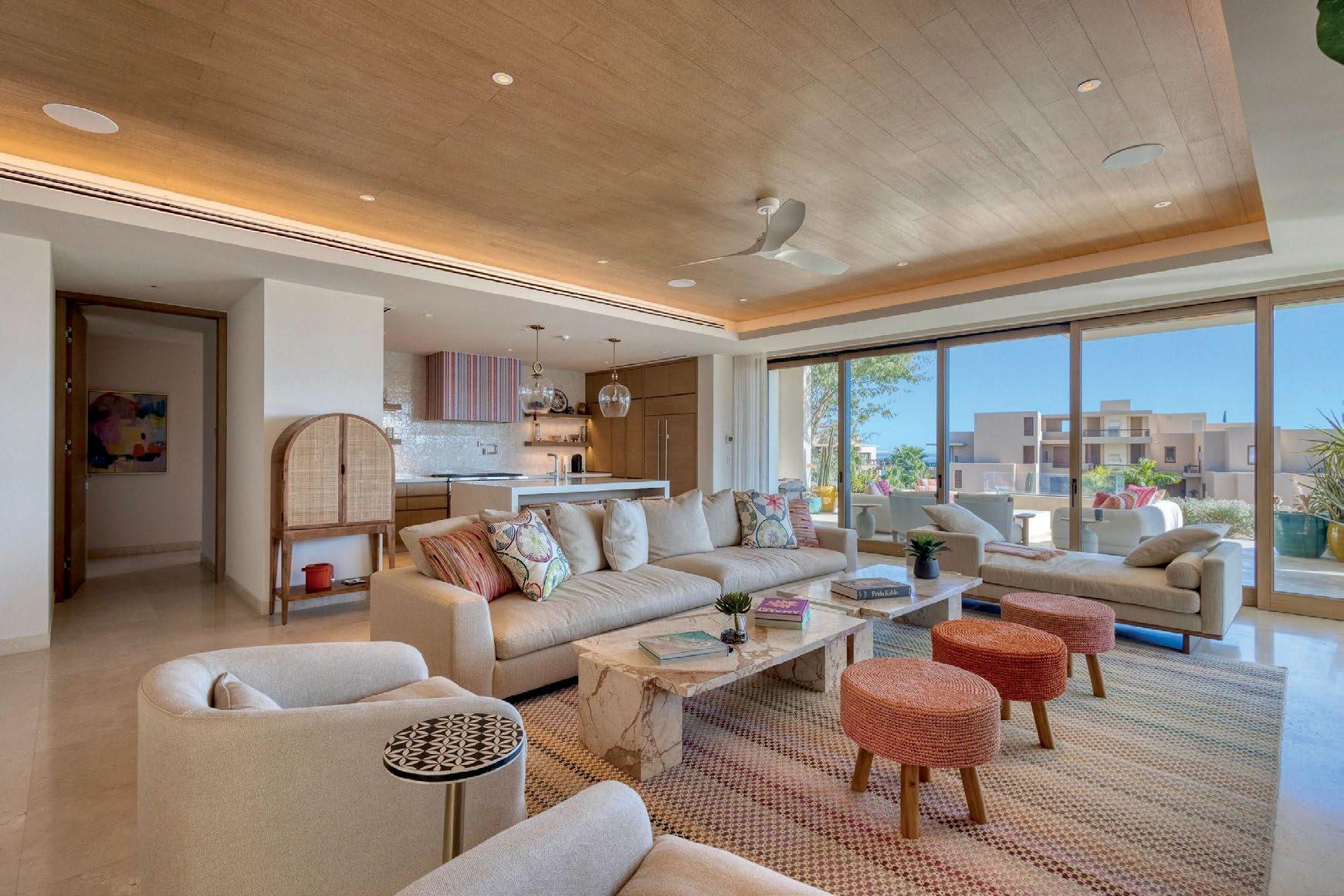


Los Cabos means “the capes” in Spanish.
Interior and exterior designs featuring exquisite natural finishes, washed natural woods and stone with performance fabrics that look great and will stand the test of time. Art is a delightful curation of local and beach photography with fun Mexican themed colors and sumptuous wallcoverings and dreamy lighting.
At House of Barrie we create exciting interiors that embrace the beachside desert vibe and lifestyle that is Cabo. The design possibilities are endless. Let us create your signature style.
Call Barrie today for an appointment or stop by our beautiful Palmilla showroom and let your design journey begin. Luxury is made easy with just one call.





As your ultimate guide to everything Baja, we understand the importance of having access to reliable and useful information while exploring a new destination. We’ve compiled a wealth of essential information specifically tailored to tourists visiting Baja. From safety tips and emergency contacts to local customs and transportation options, we've got you covered!
When you're in Los Cabos, it’s a good idea to stick to the popular areas like Cabo San Lucas and San José del Cabo. These spots are not just famous for their beauty but are also generally safer for tourists. While exploring, try to avoid wandering into isolated areas, especially after dark— it's just better to be safe than sorry. It’s also smart to keep a few important numbers handy, like the local police, your embassy, and the nearest medical facilities, just in case you need them.
Emergency: 911
American Consulate (624) 143-3566
Canadian Consulate (624) 142-4333
Cabo San Lucas Fire Department (624) 143-3577
San José Fire Department (624) 142-2466
Red Cross Cabo San Lucas 065 or (624) 143-7869
The summer sun in Los Cabos can be pretty intense, so make sure to use sunscreen regularly, wear a hat, and drink plenty of water to stay hydrated. Speaking of water, it's often recommended to stick to bottled or purified water to avoid any troubles. And if you need any medical help, there are plenty of pharmacies and hospitals around, so it’s good to know where they are before you need them.
Red Cross San José del Cabo 065 or (624) 142-0316
State Police in Cabo San Lucas (624) 143-0296
State Police in San José del Cabo (624) 142-4104
Tourist Police (624) 143-3977
Getting around Los Cabos is easy, safe, and has many options. Taxis, ride-sharing services, and car rentals are all good choices. If you decide to drive, just be mindful of local driving habits and road conditions—defensive driving is always a good idea. Public buses are another way to get around, but they can get crowded.
When it comes to handling money, it’s best to use ATMs in busy, well-lit areas and only carry as much cash as you need. Take in mind that credit cards are widely accepted. Tipping is a common practice in Los Cabos, and it’s good to know the basics. In restaurants, a tip of 10-15% is usually expected. It’s also polite to tip hotel staff, tour guides, taxi drivers, and other service providers.
A big part of what makes Los Cabos special is its people, so take the time to immerse yourself in local traditions and activities. A simple handshake is a common way to say hello. Learning a few Spanish phrases can enhance your experience in Los Cabos, and locals will appreciate the effort.
Scan this to find out today’s exchange rate!

When visiting Los Cabos, and staying in a foreign country knowing the right numbers in case of an emergency it's essential to be prepared for any situation. Below is a list of important emergency numbers to keep handy during your stay in Los Cabos, ensuring your safety and peace of mind throughout your trip.
Note: When calling a Mexican phone number from the U.S. or Canada from a landline, dial 011 then the country code for Mexico, which is 52, and then the 10-digit phone number including the area code (624 for Los Cabos). If you are using a cellphone for your call, you just have to dial +52 as shown in the numbers below.
Emergency (Police, Fire, Ambulance): 911
State Police:
• Cabo San Lucas: +52 (624) 172-5356
• San José del Cabo: +52(624) 142-4104
Tourist Police: +52 (624) 143-3977
CATAC: +52 (624) 105-0551
US Consulate: +52 (624)143-3566
• Phone from U.S. : 1 (844) 528-6611
Canadian Consulate: +52 (624)142-4333, (52) 55-5724-9797
AA:
• Cabo San Lucas: +52 (624) 122-2720
• San Jose del Cabo: +52 (624) 129-8034
• La Paz: +52 (612) 131-7459
• AMC American Medical Center
Lázaro Cárdenas # 911, El Medano Ejidal, El Medano, 23453 Cabo San Lucas, B.C.S., Mexico // Phone: +52 (624) 143-4911
• BlueNetHospitals (Cabo San Lucas)
Location: Carretera Transpeninsular km 6.3 Col. Cabo Bello, Plaza del Rey Cabo San Lucas, BCS 23455 Mexico Phone: +52 (624) 104 3910 // Emergencies: (624) 104 3911
• Hospiten Cabo San Lucas
Location: Carretera Transpeninsular KM 0,5 Condominio Maestro Plaza San Lucas
Col. El Tezal, 23454 Cabo San Lucas, B.C.S., Mexico Phone: +52 (624) 145-6000
• H+ Hospital
Location: Plaza Koral Center, Carretera Transpeninsular Km 24.5, Cerro Colorado, San José del Cabo, Mexico // Phone: +52 (624) 104 9300
• Hospital Reforma
Location: Aguajitos S/N L-3 E/Carretera A Todos Santos Y Santa Fe, Cabo San Lucas, Mexico // Phone: +52 (624) 173 1100
• Red Cross: 065 or +52 (624)143-3300
Save these numbers on your phone before arriving.

With calm waters, extraordinary fishing and perfect weather, some may argue that boating is the most popular attraction in Los Cabos. Whether you want to take a cruise to Santa Maria Bay on a luxury yacht or wake up at the crack of dawn for a fishing adventure, there are endless options to fit your needs.
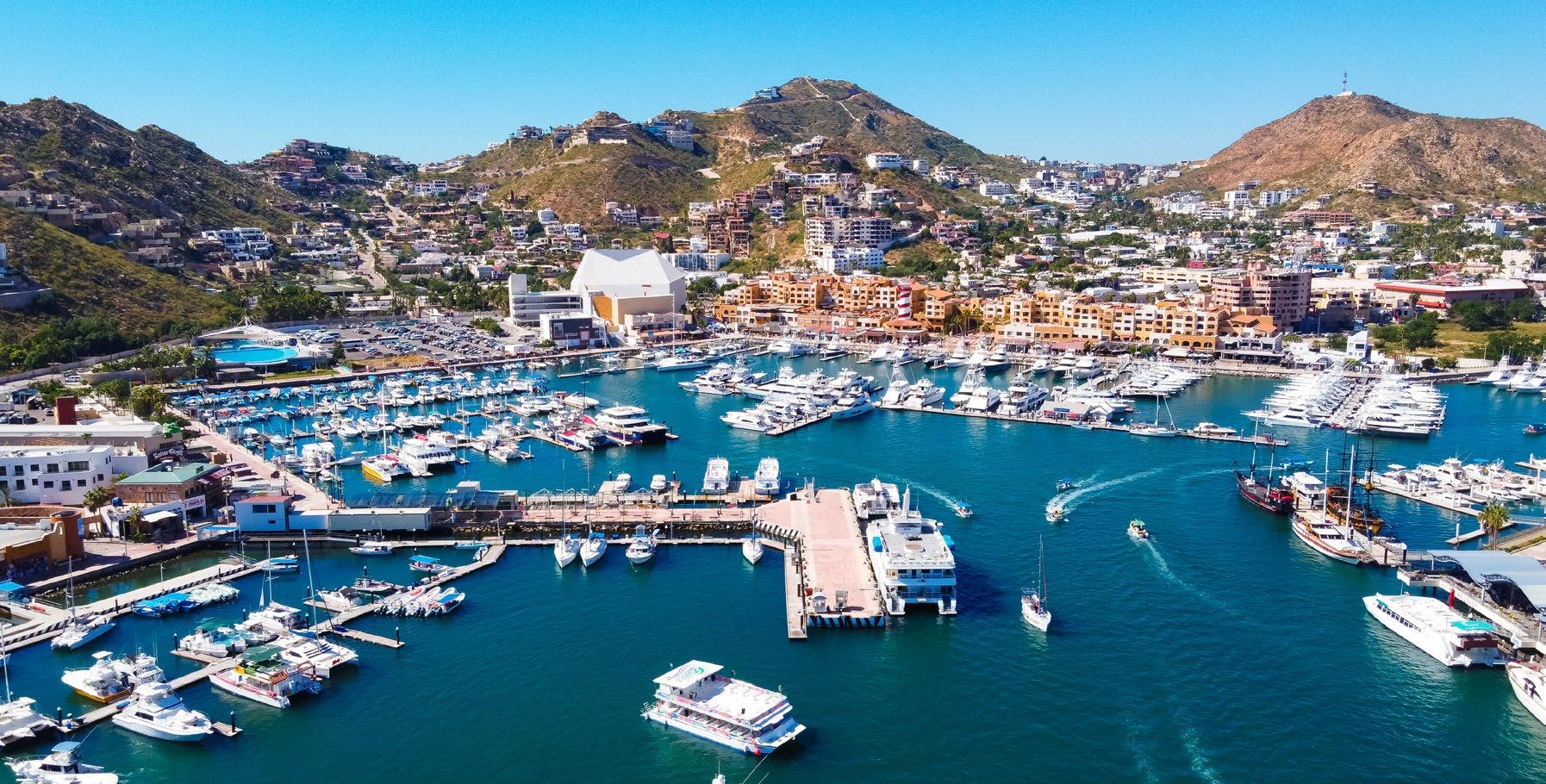
There’s a reason why the world’s richest fishing tournament
- the Bisbee’s Black & Blue - has taken place in Los Cabos for over thirty years. This part of the world offers abundant sea life and an exceptionally high catch success rate, no matter what your level of fishing experience is.
What to Expect - Most charters include a fishing license, bait, tackle and equipment. Some also include food and drink or these amenities can be added at an additional cost. Cost will depend on the number of people in your party and the size of the boat you choose to rent. It is customary to leave the crew a gratuity of 15% to 20%.
Bait and Tackle
Most likely, the boat you charter will include your bait and tackle. If you need your own fresh bait, you may buy it along the Cabo San Lucas Marina or the crew you hire may also stop to buy it from the local fishermen on your way out.
Private Charters
There are many charter companies that can accommodate your needs. What you do on your trip is really up to you,
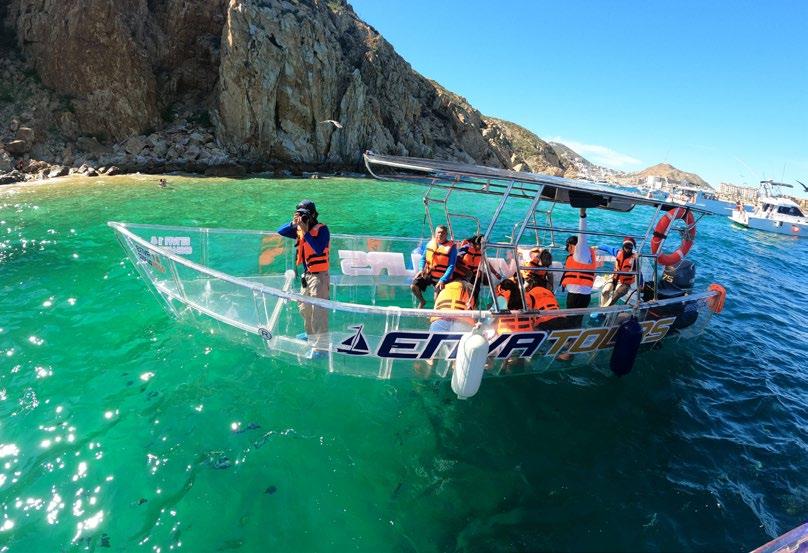
but it will typically consist of a tour of the landmark arch, a few hours of fishing, and a cruise to one of our beautiful bays for a swim. Most boats have fishing equipment and a knowledgeable crew, but the biggest difference between a yacht, sailboat and a fishing boat rental is the cost.
Fishing Boat Rentals
You can always fish on a yacht, but cruisers, pangas and super-pangas are a more affordable option. Cruisers accommodate larger groups and are more comfortable when the sea is rough on a windy day.


Marina Cabo San Lucas
The area’s largest commercial marina features 380 slips and accommodates vessels of up to 375 feet. Amenities include 24-hour security, electricity and potable water, a fuel dock, and convenient laundry and shower facilities.
Puerto Los Cabos
Located in La Playa just north of San José del Cabo is the newest marina in the area with 200 available slips for boats up to 400 feet. Amenities are similar to Marina Cabo San Lucas, though the boatyard’s 150-ton travel lift can accommodate larger vessels.



BOATING AND FISHING TERMS IN SPANISH
Captain - Capitán
Aboard - Abordo
To fish - Pescar
To float - Flotar
Wind - Viento
Tide - Marea
Fish - Pescado
Bait - Carnada
Fishing rod - Caña de pescar
Hook - Anzuelo
Life preservers - Salvavidas
Throttle - Acelerador
Anchor - Ancla
Bow - Proa
Stern - Popa
From Tiger Woods to Nicklaus and Fazio, many of the big names in golf have designed courses on this unique landscape. Many courses offer a reduced rate later in the day during twilight hours. Appropriate golf attire is required on all courses and club rentals are available.
RESORT-AFFILIATED AND PUBLIC GOLF COURSES IN LOS CABOS:
Solmar Links
Since its opening in 2020, Solmar Golf Links in Cabo San Lucas has become a top golf destination. Designed by Greg Norman, it features stunning Pacific Ocean views, desert landscapes, and Seadwarf paspalum grass for a true links experience. Highlights include revetted bunkers and the iconic island green on hole 17.
Designed by Robert Trent Jones Jr. and opened in 1994, Cabo Real has hosted multiple PGA Senior Grand Slam events, elevating its status in the golf world. A 2012 remodel reversed the front and back nines, now taking players straight to the ocean on the front nine before leading into canyons for the back nine.
As the first Jack Nicklaus Signature course in Latin America, Palmilla Golf Club has been a favorite since its opening in 1992. The course features 27 holes, divided into three unique nine-hole layouts: Ocean, Mountain, and Arroyo. With five sets of tee boxes, players of all skill levels can enjoy the experience.
Opened in 2007 and designed by Nicklaus Design, Club Campestre is known for its wide fairways, challenging greens, and scenic ocean views. Although it doesn’t have any holes directly on the ocean, nearly every hole offers stunning coastal vistas.
Cabo del Sol features two distinct courses: the Ocean Course, designed by Jack Nicklaus, and the Desert Course, designed by Tom Weiskopf. The Ocean Course, at 7,091 yards, has received international recognition for its stunning seaside holes. The Desert Course, at 7,049 yards, offers a scenic and diverse layout that winds through the hills, presenting a different yet equally rewarding golfing experience.
One of the most distinctive public courses, Puerto Los Cabos provides a composite layout featuring nine holes designed by Greg Norman and nine holes by Jack Nicklaus. Eventually, the course will expand to include full 18-hole layouts from each designer.
Vidanta Golf Los Cabos offers a fun and accessible golf experience in the heart of San José del Cabo. Originally designed as an 18-hole course, it was later reconfigured into a 9-hole, par-35 layout that still delivers a challenging and enjoyable round.
One of the earliest courses in the area, the Cabo San Lucas Country Club opened in 1994. Designed by the Dye family, this 18-hole course is conveniently located near the heart of Cabo San Lucas. While it lacks oceanfront holes, it provides beautiful views of Cabo San Lucas Bay.
Rees Jones, the architect and designer of Danzante Bay explains the elevated, island-like 17th hole par 3 “I have no doubt that number 17 will be one of the best holes in the world”. The course winds you through stunning vistas of the Sea of Cortez, as well as the beautiful mountain range of the Sierra’s. A stunner to say the least and a must-do for the avid golfer.
SEMI-PRIVATE AND RESORT
ACCESS COURSES:
Diamante – El Cardonal & Dunes Course
With rolling fairways and challenging greens, El Cardonal can test any golfer. Bring your short game as you can experience undulated greens that encourage risk vs. reward decision-making on each hole. Diamante is also home to Davis Love III’s spectacular Dunes Course. With links-style attributes, this challenging design reminds the golfer he’s only competing against himself. The course was designed with the wind in mind, rewarding you when going with the wind and challenging you when going against it.
Quivira
Located on the Pacific Ocean side of the peninsula and sure to test any level of player, Quivira boasts dramatic cliff-side landscapes and multiple oceanfront golf holes. It’s not uncommon to be playing while whales breach in the Pacific Ocean or fish jump out of the water. The on-course experience is unique in its multiple comfort stations where players can enjoy tacos, quesadillas, sliders, and of course, a few adult beverages
LIMITED RESORT ACCESS COURSES: Twin
Designed by Fred Couples, Twin Dolphin Golf Club offers an exclusive playing experience for guests of Montage Los Cabos and Maravilla. The course is characterized by arroyos, desert canyons, and ocean views, combining natural terrain with world-class design. Exceptional service and secluded play define this limited-access venue.
A Tom Fazio design, the Chileno Bay Golf Course is accessible primarily to guests of the Chileno Bay Resort and private club members. The course blends wide fairways with stunning elevation changes and ocean backdrops. Sustainability and seamless integration into the environment are core to its layout.
This exclusive Jack Nicklaus Signature course is open only to members and their guests. El Dorado offers dramatic ocean views, desert arroyos, and championship-level challenges. The course and its facilities are integrated into a private residential community emphasizing privacy and luxury.
Designed by Tom Fazio, Querencia is a private golf and beach club known for its rugged terrain, panoramic ocean views, and meticulous conditioning. The course is carved into the natural desert topography and offers one of the most visually engaging rounds in the region, reserved exclusively for members.
The reimagined Cove Club Course at Cabo Del Sol is a private Jack Nicklaus Signature layout that blends coastal views with updated design elements focused on playability and comfort. Now a part of the exclusive Cove Club community, access is limited to members and guests of the development.


There are several sites worldwide where large numbers of whale sharks congregate, and the bay of La Paz –located only 1.5 hours from Cabo San Lucas– just happens to be one of them. The whale shark is the largest fish on the planet, measuring from 18 to 40 feet, so as you can imagine the experience of snorkeling with these gentle creatures is one-of-a-kind. Whale shark season in Southern Baja is from October through April. Only go with a professional tour company who is aware of safety and responsible ecoturism guidelines.

During the winter, Mexico is not only a great place for people to escape the cold weather, but it is also excellent for whale watching. Every year, the intrepid gray whale migrates south to the Baja waters to mate and give birth. Blue and humpback whales also visit us making Baja California Sur one of the best world destinations to see whales. The whale watching season is considered to begin in December and ends in April (although it is not uncommon to see some early arrivals or some stragglers), with February being the peak month for sighting whales.
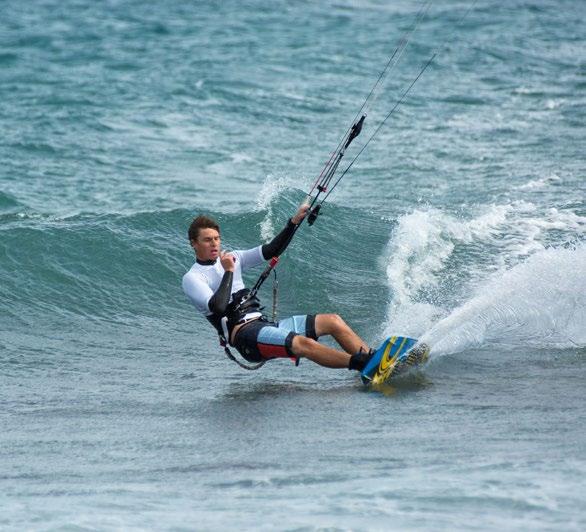
This sport is most popular in the East Cape due to the El Norte winds. Playa Norte (the north-east side of the beach) in Los Barriles is known to be the most popular destination. La Ventana is also a popular spot and is closer to La Paz. There is less wind in Los Barriles than in La Ventana, but the surf is bigger. Both locations have kite surfing schools and equipment rentals. The best months are October, November, December, January, February and March.

The San José del Cabo Art District offers a variety of world-class galleries which are open year round; however, from the months of November through June the San José del Cabo Art Walk takes place every Thursday evening from 5 to 9 pm. Walking the enchanting streets and plaza of downtown San José is an ideal way to experience the local culture while viewing art from local and international artists.

Farmers markets have become very popular in the past few years in Los Cabos and there are now many options to choose from. Some of these markets include: SANJOMO (San José Organic Maket), The Shoppes at Palmilla Farmer’s Market, The Cabo San Lucas Organic Farmer’s Market in Pedregal, El Huerto Farm to Table, Xplora and The Farmers Market at Metate. Schedules and seasons of each market vary so visit their websites or Facebook pages beforehand.
Prepare yourself for an incredible show of nature as you swim side by side colorful schools of fish, eels, rays, octopi, sea turtles and more. The Sea of Cortez or the “Aquarium of the World” offers many opportunities to experience incredible underwater wildlife. Cabo offers several methods for snorkeling. You may drive to a local beach and swim out, book a tour with one of the many popular companies, or charter a private boat. Tours are typically two or three hours and they often include a tour of Land’s End, lunch, and time for snorkeling in one of the bays. Stay away from the Pacific side of the peninsula; its strong currents make it very dangerous for any kind of water sports.



PELICAN ROCK
A quick five-minute ride from the Cabo San Lucas marina or Medano Beach is all it takes to get to this fish-attracting rock.
LOVER’S BEACH
This popular and uniquely-named beach is accessible only by boat. Be on the look-out, however, as the water is not roped off for swimmers.
SANTA MARIA BAY
Snorkel tours regularly visit Santa Maria Bay. If you choose to drive there, it’s an easy swim from the shore to the reef on the right side of the cove.
CHILENO BAY
Snorkelers will find a safe, roped-off area for swimming at this common tour destination.
PALMILLA BEACH
This beautiful beach has a very friendly reef that is just off the shore, making it an effortless snorkeling experience.
CABO PULMO
A Natural Marine Reserve in the East Cape, and may offer the best snorkeling in the area. This eight-fingered coral reef is about a 1.5-hour drive from San José del Cabo, but it is well worth it!

Experience zip-lining, back-country UTV and ATV tours, a camel safari, and more. Zip-lines are appropriate for kids 8 years and up and be prepared to hike from 5 to 15 minutes from line to line. Most companies include transportation.

WATER ACTIVITIES in medano beach
Go to Medano Beach for a day full of fun water activities. There are numerous options along the beach, such as jet skis, banana boat cruises, aquatic bikes, SUP rentals, and more! Or try a parasailing trip and gain some altitude to enjoy beautiful views of Cabo while tethered firmly to a speedboat!

Wild Canyon Adventures has a water park section which you can access with your park day pass, a perfect way to spend a full day of fun family activities. Wild Wet Fun Water Park, located about 30 minutes from San José del Cabo, has shallow pools and small slides for young children, and for adrenaline seekers they have several fast and large slides standing tall and mighty that offer a great view of the beautiful surrounding mountains. To get there take HWY 1 north from the San José International Airport towards La Paz and East Cape. After about 15 miles, take the exit for Caudaño at KM 66. Follow this road for a few minutes and you will find the park on your right.
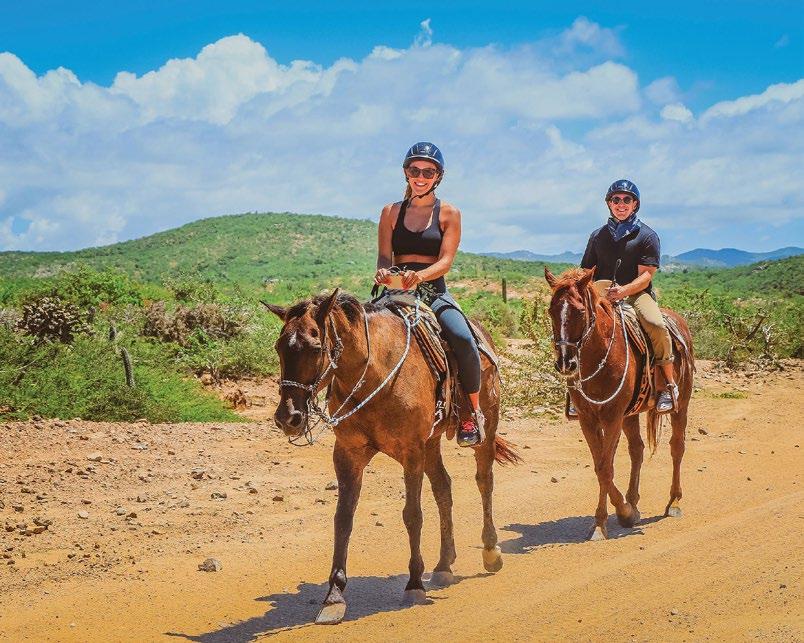
Los Cabos (particularly San José del Cabo) offers a number of horseback excursions for all ages. Saddle-up for a sunset guided beach ride, venture up a hidden canyon trail, or just sit back in the shade while experienced horse trainers give the kids lessons in horsemanship – there’s something for everyone! San José also boasts a natural estuary and nature preserve where you can enjoy a peaceful, self-guided nature walk to observe some of the lushest landscape in the area. Species of flora and fauna are abundant, dozens of species of cacti and birds can be spotted on this solitary walk, just a few minutes from downtown.
There are several local companies which offer ATVs, buggies, and other off-road vehicles for trail and beach cruising. Strap on some goggles and hop behind the wheel of one of these off-road racers for an afternoon of fast-paced fun! Tours are typically three hours, and drivers must be 16 years of age with a valid Driver’s License. If pedal-powered rides are more your speed, look into renting a mountain bike and taking a riding excursion, or maybe just a beach cruiser and joining a guided bicycle tour of town.

The Sierra La Laguna, the southernmost range of the Pacific Crest in the Baja Peninsula, is a protected natural reserve with miles of trails, streams, waterfalls, and seven dramatic canyons. It offers a striking contrast to the coast, easily accessible from the East Cape (Sea of Cortez side) or near Todos Santos (Pacific side). On the east, you can enter through canyons like San Dionisio (from Santiago), San Bernardo (from Miraflores), and San Pablo (from Caduaño). Popular day trips include Sol de Mayo waterfall in Cañón de la Zorra and the Santa Rita hot springs, both near Santiago, with easy hikes of 15 minutes or less. Don’t forget to bring cash, water, and a packed lunch.
- JUNE through NOVEMBER: The summer months are known to be the best as the Southern Hemisphere’s swells send great waves to the Pacific, Cabo San Lucas, San José and the East Cape.
- DECEMBER through FEBRUARY: East Cape and Costa Azul are on the flatter side. The Pacific can be good this time of year because it’s exposed to the west swell.
- MARCH through MAY: This is the windy season. Swells are consistent and you’ll run into fewer crowds.


SAN PEDRITO
Level: Advanced. Direction: Right, left.
Location: Pacific side right before arriving to Todos Santos. CERRITOS
Level: Beginners. Direction: Right, left.
Location: Pacific side at Km 65 of the Cabo San Lucas-Todos Santos road. MONUMENTS
Level: Advanced. Direction: Left.
Location: at Km 6.5 of the Corridor, closer to Cabo San Lucas. EL TULE
Level: Advanced. Direction: Right, left.
Location: Exit at Km 16.2 at El Tule bridge
COSTA AZUL consists of three breaks: The Rock or La Roca
Level: Advanced. Direction: Right.
Zippers
Level: All levels. Direction: Right. Acapulquito
Level: All levels. Direction: Right.
Location: at Km 28.5. Access is below the Costa Azul bridge.
LA BOCANA AT THE ESTUARY
Level: All levels. Direction: Right, left.
Location: East side of the San José del Cabo’s main beach.
SHIPWRECKS
Level: Advanced. Direction: Right.
Location: East Cape, about 25 Km from San José del Cabo. NINE PALMS
Level: All levels. Direction: Long rights.
Location: East Cape, about 30 Km from San José del Cabo.
When planning a getaway to Baja California Sur, travelers are often presented with two compelling yet very different options: Loreto and Cabo San Lucas. Both destinations offer natural beauty, rich culture, and access to the Sea of Cortez—but each caters to distinct types of experiences. Whether you’re looking for tranquility or excitement, simplicity or luxury, understanding the character of each town will help you choose the right destination for your next trip south.
Cabo San Lucas is one of Mexico’s most famous tourist hubs. Its high-energy nightlife, resortlined beaches, and bustling marina create an environment that is always in motion. Cabo is loud, colorful, and packed with entertainment options, drawing celebrities, party-seekers, and luxury travelers alike.
Loreto, in contrast, is quiet, relaxed, and rooted in tradition. As one of the oldest settlements in the Californias, it offers a serene escape where visitors can walk cobblestone streets, visit historic missions, and enjoy unspoiled beaches with few crowds. If Cabo is the main stage, Loreto is the quiet retreat behind the curtain.
Both destinations are set against remarkable natural backdrops, but they offer different types of experiences.
Cabo San Lucas is famous for its dramatic rock formations, such as El Arco, and its expansive beaches. Visitors enjoy deep-sea fishing, yacht tours, and off-road adventures into the desert. Loreto, meanwhile, is surrounded by the Loreto Bay National Marine Park, a protected area rich in biodiversity. Its calm waters make it ideal for kayaking, snorkeling, and whale watching. The nearby Sierra de la Giganta mountains also offer outstanding hiking for those seeking inland adventures. Loreto’s setting is perfect for travelers who prefer eco-friendly exploration over adrenaline-heavy excursions.
Loreto stands out as the first Spanish settlement in the Baja California Peninsula, home to the Mission of Nuestra Señora de Loreto, founded in 1697. It has maintained much of its colonial charm and is recognized as a Pueblo Mágico, a designation granted to culturally significant towns in Mexico. Visitors can explore ancient cave paintings, centuries-old architecture, and a lifestyle deeply connected to tradition.
While Cabo has its share of history, much of the town has been shaped by tourism in recent decades. The focus here is more on modern luxury than preservation. Cultural elements can still be found, but often in curated experiences rather than living heritage.


Cabo San Lucas is easily accessible with direct international flights from major cities in the U.S. and Canada. Its infrastructure is built for tourism—everything from high-end resorts to all-inclusive packages is readily available. It’s a convenient and well-equipped destination for travelers who want full-service options.
Loreto is more remote, with fewer direct flights and a smaller airport. While tourism is important here, the scale is smaller. Visitors may find boutique hotels, local guesthouses, and independently run tours rather than sprawling resorts. The town’s infrastructure supports a slower pace of travel.
Both destinations offer delicious Baja cuisine, but the experience is different. In Cabo, you’ll find a wide range of international dining options alongside upscale interpretations of regional dishes. World-class chefs and celebrity-backed restaurants are not uncommon.
Loreto, on the other hand, offers a more grounded and local food culture. The emphasis is on fresh ingredients, minimal processing, and traditional recipes. Highlights include roasted chocolate clams—a delicacy you won’t find elsewhere. Many chefs grow their own herbs and source ingredients locally, offering an authentic taste of the land.
Both Loreto and Cabo San Lucas are jewels of Baja California Sur, each offering a distinct take on what it means to escape to the edge of the Sea of Cortez. If you’re looking for energy, luxury, and round-the-clock action, Cabo is your ideal destination. But if you’re drawn to quiet beauty, cultural depth, and a closer relationship with nature, Loreto is the place to be. Whichever you choose, Baja will welcome you—whether you want to celebrate the moment or slow it down.


Researching
The first step is to research the airline's specific pet travel policies. Different airlines have varying requirements for transporting pets, including size restrictions, fees, and documentation. Some airlines may allow small pets to travel in the cabin as carry-on luggage, while larger pets may need to travel as checked baggage or cargo. Here are some popular airlines that offer pet travel to Mexico from the US or Canada:
• American Airlines: Allows small pets to travel in-cabin and larger pets as checked baggage.
• Alaska Airlines: Known for being very pet-friendly, they offer both in-cabin and cargo options.
• WestJet (Canada): Offers pet travel services for small animals in-cabin or as checked baggage on flights to Mexico.
When booking your tickets, always double-check the airline's specific policies, as they may vary depending on the size, breed, and species of your pet. Some airlines may also have breed restrictions or limits on the number of pets allowed per flight.
Pet Health & Vaccination Requirements
The airlines mandates the use of a purpose-built crate for cats or a kennel for dogs when transporting pets. Cardboard boxes, plastic containers, or other improvised carriers will not be accepted.
• Size and ventilation: The crate should be large enough for your pet to stand up, turn around, and lie down comfortably. Make sure there is plenty of ventilation on at least three sides.
• Absorbent materials: Place absorbent pads at the bottom of the crate to manage any accidents during travel.
Upon arrival, ensure you have food and water prepared for your pet. Mexican authorities permit the import of a reasonable amount of dry pet food for consumption during transit.
Arriving at the airport with your pet is a little different than flying solo. Plan to arrive early (at least 3 hours before international flights) to allow time for the following:
• Check-in process: You’ll need to check in with the airline, providing the required documentation for your pet (health certificates, rabies vaccination, etc.). The airline staff may inspect your pet's crate to ensure it meets standards.
• Security screening: For pets traveling in-cabin, you’ll need to remove your pet from the carrier and carry them through the metal detector while the crate goes through the X-ray machine. Be prepared to hold them securely during this process.
• For layovers, many airports now have pet relief areas, where your pet can stretch their legs and take bathroom breaks. Be sure to check your layover airport’s amenities ahead of time to avoid any surprises.
Traveling with your furry companion can be the best experience, but it requires careful planning and preparation, especially when crossing international borders. Los Cabos is a pet-friendly destination, and with the right precautions, you can easily bring your beloved pet along on your adventure. In this guide we’ll provide you with all the essential information you need to know, from preparing for your trip to navigating customs and enjoying your time in Mexico with your pet.
If you're driving to Mexico with your pet, a health certificate from a veterinarian and proof of parasite prevention are not required. However, you may be asked to show a rabies certificate, which varies by border crossing. There will be no inspection of your dog at the border.
Los Cabos offers a variety of pet-friendly activities and accommodations, ensuring that you and your furry companion have a memorable vacation. Here are some tips for making the most of your time together:
• Find pet-friendly accommodations: Many hotels and resorts in Los Cabos welcome pets, so be sure to book a pet-friendly property in advance.
• Visit pet-friendly restaurants and cafes: Many restaurants and cafes in Los Cabos welcome pets, so you can dine out without leaving your furry companion behind.
• Take advantage of pet-friendly activities: Some activities, such as kayaking, hiking, and whale-watching, allow you to bring your pet along.
• Explore dog-friendly beaches: Several beaches in Los Cabos allow dogs, so you can enjoy some beach time with your furry friend. Some pet friendly beaches in Los Cabos include:
• Playa El Médano (Cabo San Lucas): Dogs on leashes are allowed; mornings offer a quieter walk.
• Playa Las Viudas (Cabo Corridor): A scenic, rocky beach ideal for leashed pets.
• Playa El Tule (Cabo Corridor): Open, rocky terrain; dog-friendly but watch for waves.
• Playa Costa Azul (San José del Cabo): Leashed dogs allowed on shore; no swimming due to surfers.

• Bring plenty of water and snacks: Your pet will need to stay hydrated and nourished, especially during long flights and activities.
• Be mindful of the heat: Los Cabos can get very hot, especially during summer months. Walk your pet early in the morning or late in the evening to avoid heatstroke. Avoid hot pavement that can burn paws, and always provide shade and water during outdoor activities.
• Pack a first-aid kit: Accidents can happen, so it's always a good idea to be prepared with a first-aid kit for your pet.
• Respect local regulations: Be sure to follow all local regulations regarding pet ownership and behavior. This includes keeping your pet on a leash in public areas and cleaning up after them.





In Baja California Sur, many children and adolescents still face silent health challenges despite the region’s economic growth through tourism and real estate. Access to basic and specialized healthcare remains a struggle for many families.
Founded over 23 years ago by an American who made Cabo his second home, Los Cabos Children’s Foundation (LCCF) continues its mission to improve the health and well-being of children across the state. With more than $21 million invested in 88 programs, over 114,000 children and adolescents have benefited. LCCF supports areas such as childhood cancer, heart disease, disabilities, mental health, and prevention.


LCCF works collaboratively with medical professionals, civil society, government, and socially responsible companies to build a reliable health network. A key achievement is the Pediatric Intensive Care Unit in the state’s largest hospital—the only one in Southern Baja—which offers specialized care for critically ill children.
Believing in collective impact, LCCF cofounded the Los Cabos Community Alliance and, with partners like El Dorado, Chileno Bay, and Teleton Foundation, is bringing to life the CRIT rehabilitation center for children with disabilities, opening in December 2025. In response to the pandemic, they also co-founded the Baja California Sur Community Alliance, delivering food aid to over 97,000 families. LCCF also helped create the national Childhood Cancer Alliance, which they currently lead.
In the past year alone, LCCF has supported 40 programs, reaching over 16,000 children across the five municipalities. For the 2025-2026 cycle, 54 new projects are under review, with selections to be announced in August.
As strong advocates for children’s rights, LCCF is part of REDIM, and serves on state and municipal advisory councils related to child protection and health. Their commitment to transparency and accountability is backed by top ratings from Guidestar-Candid, Charity Navigator, and CEMEFI, which named them the regional partner for BCS in 2023.
You can be part of this change. Support LCCF by sharing their mission, joining a program tour, volunteering, or investing in a child's future. Visit loscaboschildren.org to learn more. Because at LCCF, they believe changing the world—one child at a time—is possible.









Our lifestyle guru taken in and about town. From fun design to fabulous property. Barrie is always through his creative design eye



Los Cabos in summer is generally very hot, but with a bit of planning and local knowledge, it’s easy to beat the heat while still enjoying the region’s vibrant lifestyle. The trick is to plan your activities around the rhythm of the day, starting early, resting or staying inside during peak daylight hours, and exploring cooler spaces in the late afternoon.

One of the best ways to begin your day is with an early morning hike. Trails like Cerro del Vigía or the path to the Natural Arch offer stunning sunrise views and refreshing ocean breezes. The key is to start at first light and aim to be back by 8 a.m., before the sun gains strength. Another wonderful option is a sunrise or sunset walk along the beach. The sand is cool, the air is gentle, and the ocean mist creates a natural cooling effect that feels both energizing and meditative. If you are on the pacific side you will experience the benefits of having the cooler ocean so close as it considerably cooler there.
Later in the day, head to San José del Cabo and slip into The Cellar, a cool, elegant refuge from the heat. This hidden gem offers a well curated array of Mexico’s finest tequilas, mezcals, and an impressive selection of Baja wines. It’s an educational experience as much as a sensory one, revealing the craftsmanship and heritage behind these storied spirits. You’ll leave refreshed, a bit more knowledgeable, and perhaps with a new favorite bottle to enjoy at sunset with friends.

Afternoons are best spent relaxing under shade by the pool, indulging in a spa treatment, or enjoying a long lunch in an air-conditioned restaurant or shaded beach club. Locals know to take it easy during this time—another secret to thriving during Cabo’s hotter months.
Living here year-round, I’ve learned how to align my schedule with the climate. It’s all about rhythm, local resources, and embracing experiences that cool you down while enriching your connection to this extraordinary place.



Baja California Sur is often celebrated for the luxury and excitement of Cabo San Lucas, but east of San José del Cabo lies an entirely different experience—a stretch of coastline known as the East Cape. Defined by natural beauty, historic charm, and uncrowded adventure, this 70-mile arc along the Sea of Cortez offers an invitation to explore Baja’s quieter, wilder side.


Fishing has long drawn adventurous spirits to the East Cape. In the 1950s, Hollywood icons such as Bob Hope, Desi Arnaz, and Bing Crosby made pilgrimages to this remote coastline, flying in on private planes to fish the abundant waters. Their legacy lives on today in the bustling fishing hub of Los Barriles, where visitors can launch pangas—small, agile fishing boats—for a day of sportfishing. Whether it's roosterfish, dorado, or marlin, the catches here are as thrilling as the history.
For those who prefer to stay above the surface, the East Cape’s constant breezes and calm bays create ideal conditions for a variety of water sports. Sailboarding enthusiasts will find world-class wind and open space, while kayakers and paddle boarders can explore hidden coves and inlets tucked along the rugged shoreline. Swimming is best enjoyed with a partner, especially in the secluded bays where the turquoise waters remain refreshingly cool.
Arguably the crown jewel of the East Cape, Cabo Pulmo National Park is a UNESCO World Heritage site that delivers one of the most remarkable marine experiences in North America. The park is home to a 20,000-yearold living coral reef—the oldest in the Americas—and supports a staggering range of wildlife. Protected from fishing, this underwater sanctuary is ideal for snorkeling and diving, where sea turtles, rays, and tropical fish flourish. It's easy to see why Jacques Cousteau famously dubbed the Sea of Cortez "The World’s Aquarium."
While the coastline provides no shortage of activity, those with a passion for history should set their sights inland. About an hour past Los Barriles lies El Triunfo, a former mining town that once boomed with 10,000 workers during the silver and gold rush of the 19th century. Now gently waking up as a cultural destination, El Triunfo features three unique cemeteries (for Mexicans, Chinese, and U.S. citizens), a music museum housing rare instruments, a mineral museum, a cultural center, and restaurants nestled among historic buildings. Its towering chimney stack—La Ramona—still stands as a landmark of its storied past.
Getting to the East Cape is a journey in itself, offering scenic drives that appeal to road trippers and explorers alike. Visitors can opt for a slower, more picturesque route through San José del Cabo or take the faster inland route through Todos Santos. A popular approach is to drive one way out and return the other, allowing for both efficiency and enjoyment. Along the way, stops like the Tropic of Cancer monument and roadside fruit stands add local color to the trip.
Despite new developments like the La Ribera marina and luxury accommodations such as Vidanta and Punta Pescadero Paradise Resort, much of the East Cape remains undeveloped. Dirt roads lead to tranquil beachside hotels and quiet retreats where travelers can unwind after a day of activity. Many resorts even offer to prepare freshly caught fish for guests, making each meal personal and rewarding. Whether you're paddling into a remote cove, walking through the remains of a historic mining town, or diving into ancient reefs teeming with life, the region invites travelers to go beyond the beaches—and embrace the wild, authentic spirit of Baja.



